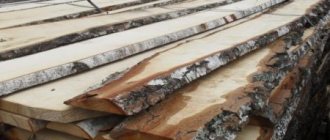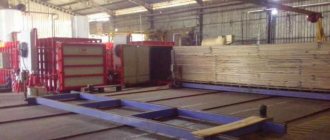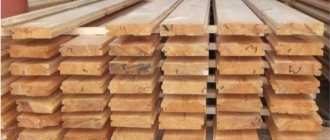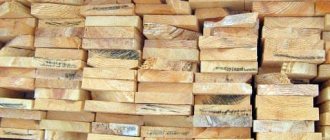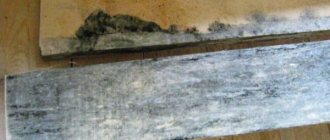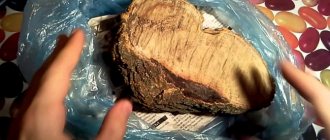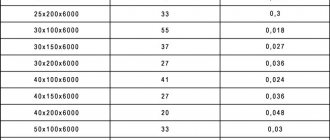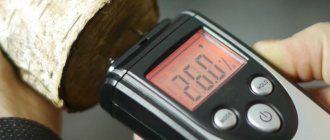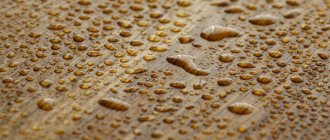Wet wood is practically not used in the manufacture of high-quality and durable wooden structures - furniture, exterior and interior decoration, as well as load-bearing elements of the building. Installation and operation of lumber is preceded by removing moisture from it. The long-known process of natural drying can last several years, which is unacceptable given the large volumes and pace of modern construction.
Physical basis of the moisture removal process
There are two main types of moisture in wood that affect the density value and technical parameters of the structure being built:
- intracellular moisture is easily removable, but is just as quickly absorbed back into the wood in a humid environment;
- intercellular water – contained outside the wood cells (also called hygroscopic). This type of moisture is the most difficult to remove and forms the basis of constant humidity (about 30%).
Drying occurs as a result of two processes - the evaporation of water and its movement from the middle of the material to the surface.
If the rate of evaporation is greater than the internal migration of moisture, then the surface dries faster. This causes uneven changes in linear dimensions and leads to the appearance of cracks and bends. The gradual occurrence of the process ensures the preservation of the structure and shape of the wood.
The basics of modern drying methods are based on several methods of influence that accelerate the evaporation of moisture from the surface of the wood:
- temperature increase;
- increasing the frequency of air circulation;
- decreased blood pressure;
- reducing the humidity of air circulating over the wood.
Drying problems
Reducing the moisture content of timber is the resultant of two parallel processes:
- Moisture exchange – evaporation of water from the surface of the timber;
- Moisture transfer – movement of water in the thickness of wood.
In order for drying to proceed without deformation and cracking of the surface, it is important that both processes proceed at an equal speed. It is clear that moisture transfer cannot proceed faster than moisture exchange: water will not move from the area of the massif where there is less of it to layers more saturated with moisture.
Let's consider three main scenarios and their consequences for the condition of the timber:
- The rate of moisture exchange is equal to the rate of moisture transfer. Drying takes place throughout the entire volume; stresses and, accordingly, deformations and cracks do not occur;
- The rate of moisture exchange is greater than the rate of moisture transfer. Stresses arise in the surface layer due to a decrease in its linear dimensions while maintaining the same dimensions of the beam core; deformations along the length are possible;
- The rate of moisture exchange is much greater than the rate of moisture transfer. Significant stresses arise on the surface of the timber, which is guaranteed to lead to cracking and deformation.
Uneven evaporation of moisture led to cracking of the timber.
What happens to wood when drying, besides removing moisture
The main processes observed in the structure of wood during drying are shrinkage and shrinkage. Shrinkage is an inevitable concomitant of moisture removal and is a reduction in the dimensions of lumber in all directions after the removal of hygroscopic moisture begins.
The increase in wood size with increasing free moisture content is called swelling . Shrinkage occurs when moisture is quickly removed, when the outer part of the tree is much drier than the inner. This phenomenon often occurs when drying thick wooden beams and logs. The occurrence of shrinkage and shrinkage is taken into account when planning future structures, as well as swelling during operation in humid environments.
When wood overheats, which sometimes occurs during heat treatment (chamber drying), a process similar to dry distillation occurs. It is the decomposition of wood fibers without access to air, resulting in the release of gaseous, liquid and solid (charcoal) products. This process is irreversible, so when heating it is important to maintain optimal temperature conditions.
More information about the drying process itself:
My book
By the way, below is my e-book, which can be obtained in the my books section. This is a superb book, and I extracted the information for it from a German from . How I remember that summer, wine and cheese, I wrote about it here.
But seriously, German technologists have come to us more than once and shared their experience. The cost of such a visit was around 2000 euros. I'm giving away my book practically for free. I just want our managers and specialists to reach the same levels of work, and our life will become much better and more comfortable.
In addition to technology, the book provides unique information about process analysis. I know that in Russia there is no analysis of the process at all. Well, we made 5 cubes of waste from 40 cubes of wood, and that’s fine. No, it's not normal. You need to analyze how much electricity is needed per cubic meter of dry wood, how many hours a person spends on laying and disassembling, and finally how much and on what equipment you end up with defects.
Technologies and methods for drying wood
Vacuum (chamber)
Drying wood in vacuum drying chambers involves creating reduced pressure in a chamber loaded with stacks of lumber. Moisture, which is in the form of saturated steam above the surface of the wood, is removed together with the drying agent. The role of the latter is played by air, which is supplied in small quantities into the chamber.
Changing the degree of vacuum and air supply allows you to adjust the rate of water removal. For material of various shapes and sizes, strict dehydration conditions are applied to maintain constant moisture content throughout the volume.
Depending on the type and size of wood, drying time lasts from several days to a month. Light conifers (pine, spruce) are the easiest to dry, while heavy oak boards have to be kept for 3-4 weeks until moisture is completely removed.
Photos of wood drying chambers
Example 1
Example 2
Example 3
Condensation
It is based on constant blowing of the drying chamber with a stream of dry heated air. The exhausted wet air mixture is sent to a cooling heat exchanger, in which water condenses after the air reaches its dew point.
This method most fully imitates the natural drying of wood. If the temperature does not rise above 40-60? C, then the structure of the material does not deform and does not undergo significant shrinkage.
Condensation removal of moisture is a development of classical chamber drying, in which the wood is kept in a stream of hot air. The conditions of chamber drying are regulated by regulatory documentation and include soft, normal, forced and high-temperature modes. The process can occur continuously in chambers of large volume and length, which provides increased productivity.
Natural
It is carried out until the wood reaches an air-dry state (about 25-30%) and does not ensure the removal of hygroscopic moisture. The lumber obtained in this way is usually used for construction purposes in the construction of structural frames that have undergone special treatment against fire and rot of supporting structures.
Drying under natural conditions is carried out in rooms that are protected from precipitation and have good ventilation. When laying, the material is placed in stacks, in which distances are left between the boards to ensure ventilation.
The video will tell you how to properly dry wood in an atmospheric (natural) way:
Why is this necessary?
Let's start by introducing some general concepts.
Based on moisture content, the following types of wood are distinguished:
| Humidity level | Description | Percentage of water to dry weight of wood |
| Wet | Long contact with water | 100% or more |
| Freshly cut | Lumber after cutting a freshly cut trunk | 50-100% |
| Air dry | Wood that has been stored outdoors under cover for a long time | 15-20% |
| Room dry | Dried indoors or in a drying chamber | 8-12% |
| Absolutely dry | Dried (sublimation) in a vacuum chamber | 0% |
Let us clarify: absolutely dry wood requires immediate conservation (application of a water-repellent coating or impregnation) and is not used in construction.
What is the difference between wet and dry wood in practical terms:
- Wet wood, unlike dry wood, has flexibility and the ability to gradually deform under load. The most obvious example is a comparison of a freshly cut twig and a dry branch of the same diameter: you must agree that they react differently to bending load;
- When exposed to atmospheric air, raw wood gradually reduces its moisture content naturally through evaporation; at the same time, its linear dimensions may decrease by 7-15% depending on the direction of the fibers;
Important: houses made of lumber with natural moisture require long-term (up to one and a half years) shrinkage before interior finishing begins. Houses made from chamber-drying dry timber exhibit minimal shrinkage during the first 3-6 months from the moment of construction of the log house; buildings made of laminated veneer lumber do not shrink at all.
A log house made of timber with natural moisture must stand until shrinkage is complete.
- Processing raw wood is much more problematic: it clogs abrasive surfaces, is sawed more slowly, and its surface is much more difficult to make smooth due to the pile rising on it;
- Finally, the main thing: during natural drying, due to its unevenness, deformation and cracking of lumber occurs. Hence the bends of the grillages and mauerlats (sometimes leading to torn out fasteners), gaps between the crowns of the log house, misaligned support columns and other troubles.
Drying chambers and their structure
Drying equipment (chambers) are cylindrical or box-shaped, lined on the outside with metal sheets. Raw wood material can initially be stacked inside or placed on special shelves.
Convection is provided by compressor units, and air heating is carried out in radiator heat exchangers. The air is supplied from above, since after contact with the wood load and evaporation of moisture, the temperature of the air mixture decreases. This causes an increase in its density and the descent of cold, humidified air into the lower part of the chamber.
Drying devices can be intermittent or continuous. In batch systems, work is interrupted while the dried batch is unloaded and a new block of wood is loaded. Continuous dryers ensure constant movement of stacks from the “wet” part of the chamber to the “dry” part, and loading is carried out as free space becomes available inside.
This video describes in detail a device for vacuum drying wood with your own hands:
conclusions
So we enter the type of wood, thickness, mode into the program and after our choice the wood begins to dry. The dryer manufacturer selects the minimum time for each stage to reduce the total cycle time. For better drying, the average drying temperature is reduced, this helps to obtain lighter dry lumber, fewer cracks, and less resin release.
The boards are placed in bags on spacers. The thicker the size of the gaskets, the easier it is for the drying agent to pass between the lumber, the smaller the loading volume of the drying chamber. Reducing the thickness of the spacers contributes to a larger load volume, but a decrease in the circulation of the drying agent and, accordingly, at some stage uneven drying of the lumber begins and the appearance of blue...
I will be glad to see your comments! Until we meet again, Andrey Noak was with you.
Wood harvesting rules
The procedure and conditions for lumber procurement are regulated in accordance with the Forestry Code of the Russian Federation.
The basic rules that must be followed during logging are as follows:
- felling of trees is carried out after submission and approval of a declaration, which justifies and describes the volume of felling, territory, type of wood, etc.;
- the first on the list for cutting down are trees that have suffered from natural causes or as a result of human activity (fire, storm, flood, disease);
- Only trees that meet age standards can be felled;
- during logging, it is necessary to remove the sawn material in a timely manner, prevent clogging of the area and demolish temporary buildings used in the work;
- It is prohibited to leave undercuts - individual trees in cleared areas.
Drying at home
High-quality drying of timber at home can be carried out using one of the following methods.
Natural drying
A diagram clarifying how to dry timber.
Advice! It is worth finding out the time of cutting a tree for timber: in autumn and winter there is no movement of sap, which means that humidity is minimal - the logs will dry out quickly.
Conditions for proper drying:
- Selection of material of the same thickness and type.
- Straight stacked material: Straight stacks and trellises between rows will increase air circulation.
- Pads at the base.
- Pegs under each other and intermediate boards in a row with pegs;
- Optimal air movement: not dense placement, so that the air flows horizontally.
- Air dampers for uniform ventilation of stacks.
- The canopy will protect from rain and sun, and a ventilated area of the site will speed up the process.
Note! Long-term drying of timber, drying timber at home, guarantees a humidity of less than 18%.
Thermal chamber
- Imitation of a dryer: non-residential premises with a brick stove and heating along the walls.
- We build stacks with our own hands, lay trellises along the rows and heat the stove, raising the temperature to 50 degrees.
- Then the room cools down to + 20.
- Let's repeat the cycle.
- In a week the timber is ready.
Advice! Final drying of planed timber is possible only in a heated room. Therefore, ventilated attics, heated sheds and garages, and residential buildings are the best storage and drying areas.
Moisture and heat treatment
This is also a kind of intermediate stage, for which special environmental conditions are created: it must provide a high intensity of moisture removal and a stable temperature regime. Such an environment is created through the same steam injection with the heaters turned on. Fans and exhaust ducts can be used in regulation. The optimal temperature for this processing mode should be 6-7°C higher than the environment at the main drying stage, but at the same time be below +100°C.
It is important to emphasize that moisture-thermal treatment is not applied to all wood species. For example, technologies for the production of dry timber provide for the use of this operation for lumber from cedar, pine, linden, the thickness of which exceeds 60 mm. Thick workpieces can be subjected to moisture-heat treatment several times to completely cover the internal structure.
